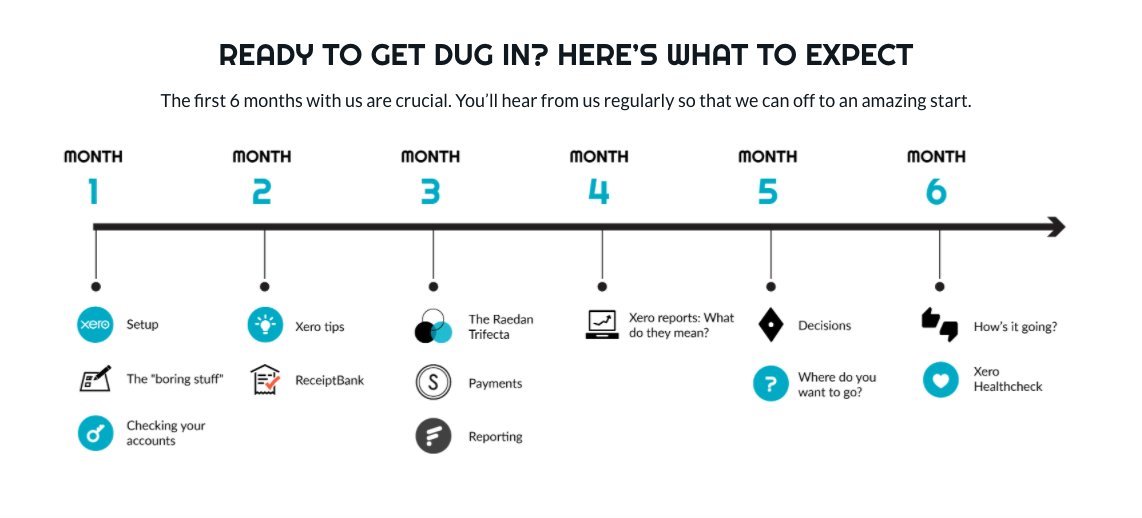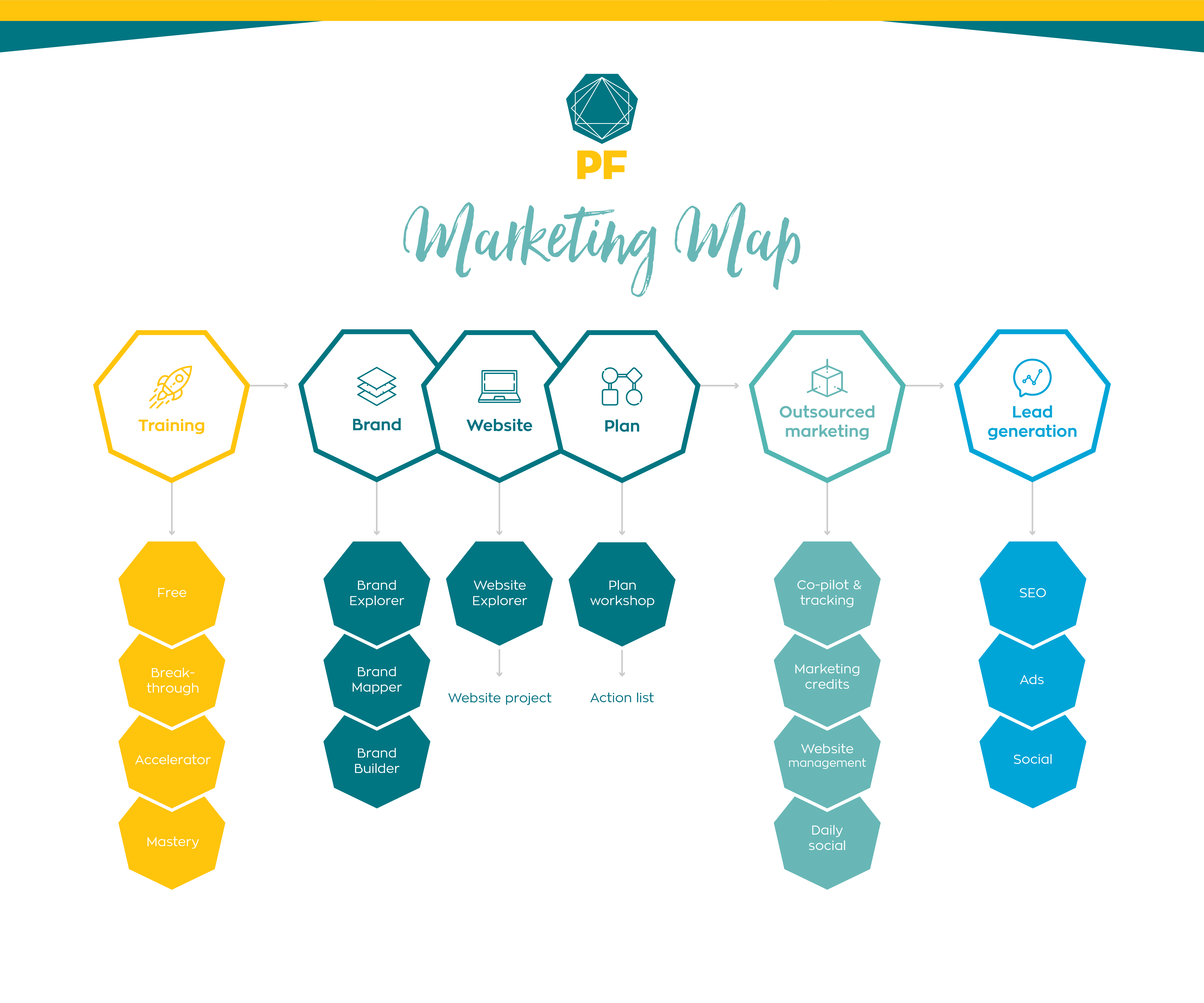
Your prospects may use a range of different software and systems but as you are the expert for your offering, you need to determine the best process for them to follow when working with you. If you change your process for each prospect, you will end up spending more time, effort and money than is necessary.
If asked if you are happy with your prospects, what would your answer be? You might say “I get loads of prospects, I don’t need to change anything”. But, how many of those prospects convert into clients? And how many of those clients are your ideal clients? If your answer is, ‘not enough’, it’s time to look at your processes.
You may need to relook at your sales process as a start but when you are trying to convert a lead, it’s also important to show them what the onboarding process looks like, what’s expected of them and how you do things at your firm. Your process (or way) could be in the form of a diagram, a How We Work landing page, a diagnostic, a video or a blog. It could be one of these items or all of these together.
Build your process to attract your ideal clients
Imagine working only with people you get on with, who don’t argue about your processes, and are happy to pay your fees. Sounds like an unreachable goal right? Well it’s not.
Knowing who your ideal client is such a critical step in your marketing journey. It allows you to focus on creating messaging to attract only your target market. Once you know who you want to help, it will be so much easier to create a process and write content for those types of people, especially when you know what issues they may have.
Once you have determined the kind of people you want to work with, consider the following:
- What are their pain points and what fears of theirs do you need to consider?
- What steps do you need to take to manage their expectations?
- Do they respond better to written communication, video, imagery or social media?
- What items do you need from them to move forward?
If you aren’t sure who your ideal client is, start by asking yourself these questions:
‘Who are your favourite clients and why do you like working with them?’
‘What work do you enjoy doing the most and what is the most profitable for you?’
‘What traits or characteristics do your favourite clients have?’
If you’d like some help with this process, our Foundations Workshop is just the thing for you. Not only will you define your ideal client, but we’ll also look at your brand to see if it attracts the right type of people and if your website offers the buyer journey that your ideal client needs. Finally, we’ll create an actions list of all the marketing ideas you could do and we’ll work out which systems and processes are working and which ones need to be created or worked on.
Once you’ve been through this exercise, you can adjust your sales process, so you only attract prospects that are your ideal clients.
Ensure your process allows your prospects to disqualify themselves if they aren’t the right fit.
You don’t need to make all the hard decisions. Allow your prospects an opportunity to disqualify themselves if they aren’t a fit.
Once you have figured out who your target audience is, start thinking of questions you could ask your prospects that will give you an idea of the type of people or business they are, in order to see if they are a good fit.
Start with a simple, short diagnostic they need to complete before they can have a call with you. If your prospect won’t even fill in the form, you’ve already got your first red flag as this indicates they aren’t taking this seriously and aren’t willing to put in the time.
If you are concerned about your prospects questioning your fees, you could ask something like “what are you looking for in an accountant?” and have “low cost fees” as one of the answer options. If your prospect ticks this one only, this hints towards the fact they are only price conscious and don’t really care about anything else. This doesn’t mean you don’t work with them, it just means you are aware this could be an issue when it comes to payment so it may be worth a discussion up front.
If you only want to work with larger businesses that are already established, you could ask how many clients or employees the business has or what their annual turnover is to give you an indication of size.
Don’t be afraid to ask personal questions. In our Online Marketing Diagnostic, we ask our prospects to share something personal about themselves so we can get to know them a little more.
It’s so much more than a business relationship for us and knowing you personally helps us to understand who you are and what makes you tick. If our prospects aren’t willing to share, this hints towards the kind of working relationship we might have with them if they become a client.
- Be clear about who you are as a firm.
- Record a video so they get to meet you virtually before they meet you in person.
- Have a page on your values and what’s important to you and your team.
Remember, you won’t attract everyone, and that’s okay. In fact, it’s exactly what you want…because you only want to attract your ideal clients. Ten ideal prospects is better than 100 prospects who aren’t the right fit.
We know it’s hard to say no to someone who wants to work with you, especially if you are just starting out. You’ll take all the work you can get, right? But taking on a client who isn’t an ideal fit for you means you are most likely going to have issues down the road.
Write down your process so you and your team are 100% sure of how things are done.
Before you share your process with your prospects and clients, you and your team need to be 100% sure of the way you do things. Start by writing down how you do things currently and how you envision your process to be. Then chat with your team to figure out if anything needs to change. It’s critical to write things down so you have something in black and white to refer to. Your team needs to be on the same page so all your clients get the same experience and your team has confidence in what they are doing.
This will also help with your hiring and training processes.
- Start with something simple – use a Gsheet to document your process. It doesn’t need to be hugely technical or fancy. Our ‘PF Way’ is documented on a Gsheet so everyone has access and we have a different tab for each system or process. You can add links to forms or web pages as needed and update it easily without the hassle of re-saving and sending each time.
- Revisit your process often – your process is going to change constantly, especially in the beginning. After having put your process to the test, you might realise something didn’t work the way you had imagined it or perhaps you’ve found a different way that’s easier or more cost effective. It’s okay to continue updating your processes and systems as your business changes. In fact, we’d advise you to.
- Have new team members review your processes – when you have new team members join your team, get them to review your processes. Explain why your process exists and what you want to get out of the process and then listen to their thoughts and suggestions.
Sometimes when we follow the same process for a long time or are too deep into a process, we can’t visualise ways to improve it. Having an outsider’s perspective often helps to simplify and find new ways to do things. They’ll help you move away from thinking ‘but this is how we’ve always done it’ to ‘is this the best way to do things?’.
Now that you’ve written out your process, it’s time to share it with your prospects and your clients.
Have your processes on your website to manage expectations
Your prospects are scared, anxious and unsure when they come to you. It’s your job to do whatever you can to quell their fears. Tell them what to expect when they work with you so they can feel reassured you know what you are doing and you are able to look after them and lead them in the right direction.
- Make your process easy to find – Create a landing page on your website that can be viewed by anyone. The more open you are about the way you work, the better. If your prospect is able to understand how you work before they even speak to you, you can spend your time digging into what their issues are and how you can help and not worry about explaining how you do things.
- Keep it simple – Don’t overthink it. If you can’t afford to have something beautifully designed or you just don’t have the time, that’s okay. Just show your process steps clearly and briefly so your prospects know what’s going to happen when. You can build onto your process as you go. Start with a video, create an image, then create a blog, then build a landing page with more information.
- Explain why you have this process – On our PF Marketing Map page, we have a webinar video talking about our Marketing Map and why we created it. It explains where the idea for the map came from, gives examples of other client’s journeys through the map and how to use it for your own marketing journey. We require everyone we work with to watch the Marketing Map webinar as a start so they understand the way we work. If they aren’t willing to commit to the process, they most likely are not the right fit for us.
- Create your process visually – people respond better to imagery than they do to words. Wherever you can, create simple visual representations of your processes to make it easier for your prospects to understand.
Make sure your process diagrams are branded and are in your brand fonts and colours. Even something as small as icons need to match the rest of your website. Your diagram needs to make sense by itself so it can be shared on its own, but you can add additional information in the form of blogs or a landing page if your prospects want to dig a little deeper into your process.
We created this 6 month onboarding process diagram for Raedan, which clearly shows what happens in the first 6 months of becoming a client.

The PF Marketing Map is a visual we’ve developed over time, not something we put together overnight. Over the last few years, we realised the clients that were getting the most out of their content marketing and the best leads, had followed a certain path with us, starting with training and education.

Many of our prospects come to us not knowing where to start with their marketing. Providing a map and being able to show them where they are and what they need to work through has become invaluable.
When we show our prospects our way, they feel like they have a plan, somewhere to start and something to work towards. We’ve had proven results from people who have followed the plan and each step along the map has its own mini plan to work through.
Share your process any chance you get
Besides having it on your website, talk about your processes with your networking groups, bring it up at events, record videos for each stage of your process and share snippets of it on social media.
In some instances, your process could even become your cornerstone piece of content, a piece of content that sits at the heart of much of what you share.
Although your prospects would have been introduced to your process before they signed up, repetition is key. Go through the process during your onboarding call as well and give them the opportunity to ask any questions they may have.
Some of your prospects might not agree with all of your processes or the way you work, but if they really want to work with you, and are the right fit, they will eventually follow your way. If you are clear on the way you do things upfront, this helps manage expectations and paves the way for a successful working relationship.

